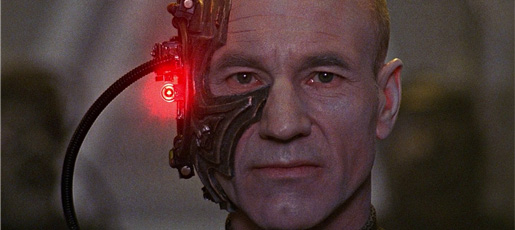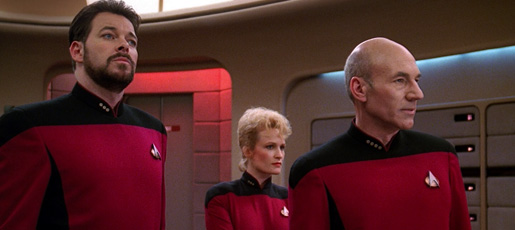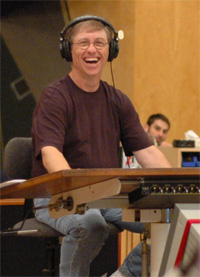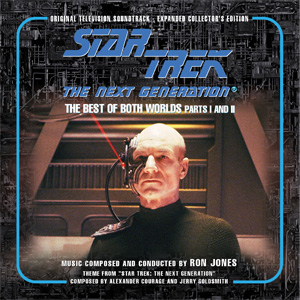This week sees the release of a definitive expanded edition of the soundtrack from Star Trek: The Next Generation‘s “The Best of Both Worlds”, issued by well known Star Trek soundtrack label GNP/Crescendo. We caught up with soundtrack Producer Lukas Kendall and chatted to him about the new “Best of Both Worlds” release. Lukas is a familiar name to Star Trek fans through his soundtrack label and magazine Film Score Monthly. As a huge proponent of Ron Jones’ Star Trek scores, we were keen to find out what this release means to Lukas after he’s campaigned so tirelessly to release the whole canon of Ron’s Trek opus.

Lukas Kendall: Best of Both Worlds Interview
Interviewed by Adam Walker for TrekCore.com
![]()
TrekCore: Hi Lukas! Tell us a bit about the backstory to this expanded edition. GNP/Crescendo originally released the incomplete soundtrack in 1991 and The Ron Jones set featured a further 5 minutes of cues—help fans understand the journey to this full release.
Lukas Kendall: The backstory of this release is the backstory of all of the recent Star Trek expanded soundtracks, which have required a deliberate and methodical process. The Star Trek music rights are not like the video rights—there, Paramount owns the video rights to all of the Star Trek feature films, and CBS, respectively, owns the video rights to the TV series, so it’s relatively cut-and-dried. Every time Paramount did a new movie or TV show, they entered into a licensing relationship with a record label for the soundtrack album—Paramount did not have their own label, so they contracted with whichever one was bidding the most, or was the flavor of the month, or had an artist on the soundtrack (like MCA’s The Yellowjackets on Star Trek IV). The album agreements were almost always drawn up “in perpetuity,” the result being that the Star Trek soundtrack rights are scattered throughout the music industry.
Every time we do a reissue, we have to involve not only Paramount (for the feature films) or CBS (for the TV programs) for the newly released tracks, artwork and packaging, but the original label (or its successor) for the underlying soundtrack album rights. It can be very difficult, simply as a bureaucratic matter, as well as a financial one, making sure there is enough money to satisfy each partner. For years it had been impossible even to try, because Paramount had a policy of not dealing with their legacy soundtracks, but around eight years ago they had a personnel change, and their current administration is very active and interested in promoting their film music archives.

22 years after the first release of “The Best of Both Worlds” as a CD soundtrack, fans can finally own the complete expanded edition of the episodes’ scores.
With regards to “The Best of Both Worlds,” GNP/Crescendo was very active in the late 1980s and 1990s and became the de facto home for Star Trek soundtracks. They had acquired the Original Series master tapes (which had been in private hands since the early 1970s) and forged a very strong relationship with Paramount to do the first-ever original soundtrack releases from TOS as well as several TNG-era CDs, including “The Best of Both Worlds.” Over time they had changed their activities and weren’t doing much with their soundtrack properties. When I did the Ron Jones box set (still available) through my company, Film Score Monthly, it was so large and expensive just by itself (and with Interplay for the two Ron Jones game soundtracks), I didn’t want to add a further expense by trying to sublicense any content from GNP/Crescendo. There was a clause in the BOBW record agreement that allowed me to use up to five minutes of music from “The Best of Both Worlds” without involving GNP/Crescendo, so that’s what I did.
Some time thereafter, we had gone through most of the available Star Trek feature and TV soundtracks, and the time came to approach Crescendo about the titles that they control. So I called them up and asked if they’d be interested in doing expanded editions, particularly of First Contact. They are not strangers to me. I had met Neil Norman for the first time when I was 17, visiting L.A. as a film music fan all those years ago, and Neil was always very supportive of Film Score Monthly when it was a magazine. Star Trek fans may not know what a fascinating history Neil’s family has: GNP stands for Gene Norman Presents, Gene being Neil’s father, who had a famous Hollywood nightclub called the Crescendo. Neil has an amazing knowledge of Hollywood music history, and his label controls a fantastic catalog of jazz recordings. I stood with him outside the old Hamburger Hamlet on Sunset Blvd., and he pointed down the street at each building and could name what famous studio, club, office or store used to be there. Neil was personally a sci-fi fan (well before that was trendy or common) and invested tremendous sums of money in the Star Trek soundtracks, as well as titles like Lost in Space and Mission: Impossible, back when the CD business was quite different and required a lot more capital investment.
So I reconnected with Neil and his wife Melanie Clarkson, who handles most of the operations for the label, and I’ve had a great experience producing or co-producing several projects for them: First Contact, Generations, the TOS box set through La-La Land Records (using the master tapes that Crescendo had archived), and now “The Best of Both Worlds.”
So that’s the story!
TrekCore: From the newly included material, what has you most excited?
Lukas Kendall: To tell you the truth, the newly included material on the new BOBW CD (those cues not on the original album or among the five minutes on the Ron Jones box set) is only a few short pieces—transitions and such. The pleasure for me comes from having everything finally in sequence and edited together. There were a couple of segues that were meant to be a certain way in the program but placed differently on the original CD that make more musical sense now. The sound quality is excellent—not tremendously upgraded from the existing CD, because we used the same Armin Steiner two-track mixes that were always meant to be used, but we corrected a few glitches while remastering, and we did tweak the mix to boost the choir for that famous act-out with the synth choir for the Borg cube, so it sounds the way it does in the show.

Lukas Kendall doesn’t hesitate in describing the score to “The Best of Both Worlds” as sensational and cinematic in nature. Coupled with the gloriously remastered Blu-ray of “The Best of Both Worlds”, fans can now own the complete expanded soundtrack in this new release from GNP/Crescendo.
TrekCore: Where does TNG music go from here? We’ve now got Ron Jones complete Star Trek canon plus an array of collections. Is there anything left that you’d like to see released?
Lukas Kendall: There are definitely more TNG scores that are worth releasing. “Power Play” by Jay Chattaway comes to mind. I am more of a hired gun now, doing what the labels want, rather than initiating projects on my own (cue Madeline Kahn from Blazing Saddles, “I’m Tired”).
I would love to release the Animated Star Trek music library but we have never been able to locate any music masters, sorry to say, so don’t plan on it!
TrekCore: What makes the music from “The Best of Both World Worlds” so iconic to you? Why does this episode, above all others, deserve a full score release?
Lukas Kendall: I tried to explain in the liner notes what it was like as a fan to watch Part I of “The Best of Both Worlds” in the spring of 1990. We truly had no idea what would happen, which characters would live or die. Nowadays, cliffhangers are commonplace; every episode of True Blood ends in a cliffhanger. But television was almost always self-contained back then. A “grown-up” show like L.A. Law would have ongoing storylines, and something like Knight Rider would do a two-parter with Michael Knight’s evil twin, but have you tried to watch Knight Rider as a grown-up? It’s deadly. Star Trek had never done a cliffhanger, save for the two-part “The Menagerie” which incorporated the unsold pilot, “The Cage”—and very few Star Trek fans actually watched it at the time of its original broadcast. Most of us discovered the show well after the fact. So we had never experienced this kind of cliffhanger—save for Spock dying in Star Trek II, but that was nothing like cutting to black after Riker says “Fire!” So the summer of 1990 was the most delightful agony waiting for the conclusion—I even remember thinking, as I was in high school at the time, “Summer vacation is almost over, which is a drag, but at least I’ll find out what happens on Star Trek”! BOBW is not directed nearly as well as “Q Who” but it’s riveting because of how well they established the Borg as unstoppable…and it inevitably disappoints in Part II, but what can you do?
And the music is sensational. When the Borg cube appears on the viewscreen and you hear the synth choir theme, you really sit up and take notice—in a good way. Sometimes when you notice the music, it’s bad—the music has something wrong to call attention to itself. But here, the music elevates the story, it heightens everything without crossing the line into melodrama. The score is cinematic, which is something that the TNG-era shows got away from—which is to say, using the tools of cinema, be they editing or music or mise-en-scène, to express the storytelling. TNG as a whole was very stilted in that way, with that Masterpiece Theatre aesthetic. Ironically the only thing that flourished as pure artifice was that ludicrous technobabble, which was its version of Shakespearean dialogue. This was Rick Berman’s taste; he was in charge, and he hated traditional dramatic scoring. But the show in its early years had a great deal more variety, not just to the music, but the cutting and staging; watch “11001001” and see the tracking shot of the empty Enterprise corridor before the cut to Minuet in the Holodeck—that’s cinema. It would be unthinkable in a latter-season episode…although I’d probably have to re-watch the episodes to see if this is true, or just my memory playing tricks on me. I remember how frustrating it was to watch the first two years of TNG because it was so inconsistent. But when they hit on a gem—many of them directed by Rob Bowman—I still think those episodes (“Where No One Has Gone Before,” “11001001,” “Heart of Glory,” “Q Who”) are better than anything from the later years, because they are miniature movies.
TrekCore: Finally, talk to us about Ron Jones the composer. Do you feel his music holds up to modern audiences and does it carry the same gravitas and punch it did back when we first heard it in the early 90s?
Lukas Kendall: Ron’s scores hold up to me, absolutely. He was and is the complete package—he can do everything that a great film composer needs to be able to do. Ron’s creative process is to analyze the movie or episode first as a storyteller, not just as a composer. He finds its literary themes, challenging himself to analyze  its emotions and values—he asks himself, what is the human foundation of the story? Then he translates that into musical material (melody, harmony, rhythm, color), and only then does he write the score. He doesn’t just play into keyboards while watching the footage—let’s back up, Ron is one of a handful of composers left who still writes everything on pencil and paper! There are two schools of how to write to picture: there’s the Vangelis school, where you are improvising on keyboards to the video, and then there’s the John Williams school where you are writing with pencil and paper. Most film music today is artistically worthless because it is played to picture, and what you are hearing is the composer’s fingers, you are not hearing his or her brain, and whatever he or she has played is then orchestrated by a team of musicians, and it all sounds the same because it is pianistic music—left-hand, right-hand—translated (not very imaginatively) to orchestra. Very few people are as gifted and talented as Vangelis, or for that matter Hans Zimmer, who can do something wonderful in this way. Film music in the orchestral tradition, with rare exceptions, only works if it is composed with the brain—not with the muscle memory of someone’s fingers. That means pencil and paper, that’s how Ron was taught, and how he still works.
its emotions and values—he asks himself, what is the human foundation of the story? Then he translates that into musical material (melody, harmony, rhythm, color), and only then does he write the score. He doesn’t just play into keyboards while watching the footage—let’s back up, Ron is one of a handful of composers left who still writes everything on pencil and paper! There are two schools of how to write to picture: there’s the Vangelis school, where you are improvising on keyboards to the video, and then there’s the John Williams school where you are writing with pencil and paper. Most film music today is artistically worthless because it is played to picture, and what you are hearing is the composer’s fingers, you are not hearing his or her brain, and whatever he or she has played is then orchestrated by a team of musicians, and it all sounds the same because it is pianistic music—left-hand, right-hand—translated (not very imaginatively) to orchestra. Very few people are as gifted and talented as Vangelis, or for that matter Hans Zimmer, who can do something wonderful in this way. Film music in the orchestral tradition, with rare exceptions, only works if it is composed with the brain—not with the muscle memory of someone’s fingers. That means pencil and paper, that’s how Ron was taught, and how he still works.
Ron’s scores hold up because they have structure, they have literary and musical integrity, and they are at once musical and memorable while still being transparent to the experience of watching the story—that’s the mark of a great film composer. It’s not easy. All it takes is one wrong note and the melody is wrong or the chord has the wrong feeling or the orchestration sounds too heavy or too light; there’s an immense amount of knowledge that goes into great scoring.
Ron is passionate about the truth, and to him the truth is the drama of any particular episode—even when the episode comes up short—and evoking it musically to the best of his ability. For Star Trek, it’s been twenty years, but those episodes he did are still out there, being watched and heard, and I’m glad Ron drove himself as hard as he did to make the scores great. It’s a shame he got the axe but he’s not a company man, he’s a truth teller—he would tease Rick Berman about the Enterprise having K-Mart carpeting—and at a certain point, people who are not fundamentally creative are going to tire of him.
At the time, Ron’s scores were utterly captivating to me, the way they enriched and deepened the Star Trek universe. I would videotape the episodes and re-watch them just for the music. An episode like “The High Ground,” with the terrorist attack on the Enterprise halfway through, I’d run that over and over again, just to experience the cutting and the music and the drama. It’s brilliant, a mini-movie unto itself. That’s why I did the 14-disc box set of his Star Trek music, for the kid in me who always wanted it—and anyone and everyone else for whom it means something. The scores still hold up to me. So I’m honored with this “Best of Both Worlds” CD to be able to complete Ron’s Star Trek soundtrack library.

High-resolution cover art for the Expanded edition of “The Best of Both Worlds”, released from GNP/Crescendo this week.
The CD contains the complete score to “The Best of Both Worlds”. Our previous article contains a full track listing illustrating the new material compared to the 1991 release. You can order your copy now from GNP/Crescendo at their website for $19.95. Discs will be shipped on Friday May 24, 2013.
Stay tuned to TrekCore for our opinion on the new “The Best of Both Worlds” soundtrack release – we hope to be able to review the disc in the coming weeks!
